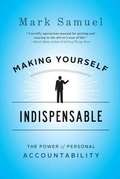- Table View
- List View
Making Vision Stick (Leadership Library)
by Andy StanleyThere are lots of books about discovering or developing a vision for your organization, but this one is about making that vision endure the corrosion of time and complexity--how to make your vision stick.Influential author and pastor Andy Stanley reveals the reasons why leaders' visions often falter, and he delivers 5 in-depth strategies so that you can dodge the pitfalls:How to state your vision simply.How to cast your vision convincingly.How to repeat your vision regularly.How to celebrate your vision systematically.How to embrace your vision personally.Many of us have good ideas, even great ones. The difficult part is putting them into practice and keeping that vision clear and visible to your organization--whether that's a business or a church--when there are so many things in the day-to-day living of that vision that can distract from it.Making Vision Stick offers valuable, practical tips and case studies. This is a book you'll want to highlight and dog-ear and pass around as you learn how to propel your organization toward the vision God has granted you.Vision is about what could be and should be, but life is about right this minute. The test of a true leader is in keeping that vision on track, day in and day out.
Making Waves and Riding the Currents: Activism and the Practice of Wisdom
by Charles HalpernThis memoir is about working for a compassionate and sustainable world. This teaches how to integrate the inner and outer work of one's lives through the practice of wisdom.
Making Waves: A Woman's Rise to the Top Using Smarts, Heart, and Courage
by Lisa Lutoff-PerloFollow the incredible career journey of Lisa Lutoff-Perlo, from her stories as an ambitious young woman to President and CEO of Celebrity Cruises to Vice Chairman for External Affairs at Royal Caribbean Group. A shining testament to the value of being an authentic leader and never sacrificing your integrity, Lutoff-Perlo details the ins and outs of her extraordinary 40-year career. She has risen to the top in a male-dominated industry, while refusing to compromise her values and bringing countless others along with her. Along the way, she ultimately transformed and redefined relaxed luxury cruising with the launch of the bold, innovative Edge Series ships in 2018, which drove unprecedented demand for Celebrity Cruises and propelled the brand&’s financial performance. She climbed the corporate ladder from the very bottom and overcame countless obstacles to reach the top of the cruise industry. In Making Waves, Lutoff-Perlo walks readers through her triumphs, hardships, and learning moments. She breaks down her unique leadership style as the first woman to take the helm as President & CEO of one of the Royal Caribbean Group&’s brands that catapulted Celebrity Cruises to heights no one thought possible, simply by caring deeply for people and putting others first. Readers will learn how she used her superpowers to set herself apart from other leaders—leaving guests and employees in awe of her authenticity and kindness. Individuals from all walks of life will take heart and gain insights they can apply to their own lives and careers: to have integrity, to pay it forward, and to make waves, wherever and whoever they are.
Making Work Visible
by Jack Whalen Margaret H. SzymanskiIn the 1970s, Xerox pioneered the involvement of social science researchers in technology design and in developing better ways of working. The Xerox legacy is a hybrid methodology that combines an ethnographic interest in direct observation in settings of interest with an ethnomethodological concern to make the study of interactional work an empirical, investigatory matter. This edited volume is an overview of Xerox's social science tradition. It uses detailed case studies showing how the client engagement was conducted over time and how the findings were consequential for business impact. Case studies in retail, production, office and home settings cover four topics: practices around documents, the customer front, learning and knowledge-sharing, and competency transfer. The impetus for this book was a 2003 Xerox initiative to transfer knowledge about conducting ethnographically grounded work practice studies to its consultants so that they may generate the kinds of knowledge generated by the researchers themselves.
Making Work Visible: Exposing Time Theft to Optimize Work & Flow
by Dominica DeGrandisToday's workers are drowning: nonstop requests for time, days filled to the brim with meetings, and endless nights spent heroically fixing the latest problems. This churn and burn is creating a workforce constantly on the edge of burnout.In this updated edition, IT time management expert Dominica DeGrandis reveals the real crime of the century―time theft, one of the most costly factors impacting enterprises in their day-to-day operations.Through simple solutions that make work visible, DeGrandis helps people round up the five thieves of time and take back their lives with time-saving solutions. Chock-full of exercises, takeaways, real-world examples, colorful diagrams, and an easy-going writing style, readers will quickly learn effective practices to create high-performing workflows within an organization.And now, with this updated second edition, readers will get more exercises plus a new afterword from the author featuring new learnings from the past five years.The technology world―and indeed the whole business world―is moving at a pace faster than ever before, and it shows no signs of slowing down. Instead of consigning ourselves to the pressure cooker of the modern world, it's time to elevate how we work. It's time to level up our game. It's time to make work visible.
Making Work Visible: Exposing Time Theft to Optimize Work & Flow
by Dominica DeGrandisIf someone stole your wallet, you'd notice it. So why don't people notice when they are robbed of something much more valuable than their wallet—time?Today's workers are drowning: nonstop requests for time, days filled to the brim with meetings, and endless nights spent heroically fixing the latest problems. This churn and burn is creating a workforce constantly on the edge of burnout. In this timely book, IT time management expert Dominica DeGrandis reveals the real crime of the century—time theft, one of the most costly factors impacting enterprises in their day-to-day operations.Through simple solutions that make work visible, DeGrandis helps people round up the five thieves of time and take back their lives with time-saving solutions. Chock-full of exercises, takeaways, real-world examples, colorful diagrams, and an easy-going writing style, readers will quickly learn effective practices to create high-performing workflows within an organization.The technology world—and indeed the whole business world—is moving at a pace faster than ever before, and it shows no signs of slowing down. Instead of consigning ourselves to the pressure cooker of the modern world, it's time to elevate how we work. It's time to level up our game. It's time to make work visible.
Making Work and Family Work: From hard choices to smart choices
by Gary N. Powell Jeffrey H. GreenhausMaking Work and Family Work investigates the difficult choices that contemporary employees must face when juggling work and family with a view to identifying the smart choices that all parties involved—society, employers, employees and families—should make to promote greater work–life balance. Leading scholars Jeffrey Greenhaus and Gary Powell begin by identifying the factors that work against an employee’s ability to be effective and satisfied in their work and family roles. From there, they examine a variety of factors that impact the decision-making process that employees and their families can use to enhance employees’ feelings of work-family balance and families’ well-being. Covering a comprehensive set of topics and perspectives, this fascinating book will appeal to upper-level students of human resource management, organizational behavior, industrial/organizational psychology, sociology, and economics, as well as to thoughtful and engaged professionals.
Making Your Data Center Energy Efficient
by Gilbert HeldDetailing powerful methods for reducing the energy costs associated with operating a data center, Making Your Data Center Energy Efficient examines both equipment and building facilities. It reviews the rationale for conserving energy and demonstrates how conservation and careful equipment selection can lead to significant improvements to your bottom line. For those not well-versed in financial or energy terms, the first two chapters provide a detailed discussion of the terms associated with different types of energy, as well as how to compute the return on investment for energy conservation efforts. The text includes tables of monthly expenses associated with operating equipment that will help you convert problems into simple table lookup processes. Among the money-saving topics discussed, it considers: How to minimize the energy consumption of a wide range of devices A little-understood topic that can make a big impact on energy costs-general heating and cooling Techniques required to effectively monitor different types of meters Phantom energy usage and methods for minimizing its cost to your organization Recognizing that most readers may not have direct control over the selection of a furnace or hot water heater, the book provides you with the ability to recognize the efficiencies and inefficiencies of various types of devices, so you can provide input into the decision-making process. From replacing lighting to consolidation and virtualization, it provides you with the well-rounded understanding needed to properly manage all aspects of the energy consumed in your data center.
Making Your Leadership Come Alive: 7 Actions to Increase Your Influence
by Jeremie KubicekAnyone can make an impact. All you need is influence--the most potent professional asset on the planet. The problem is that influence is also the most underused asset on the planet. And the primary reason is that the enemy of influence is a universal human trait: self-preservation. You guard your ideas, your status, and your reputation. Within your self-constructed walls you must cast safer visions, take smaller risks, and accept shallower relationships to ensure the security of all you are protecting. This is the downside of self-preservation: While your walls protect you and yours from demise, they also restrict your influence. You must break down your walls of self-preservation and sacrifice your security for the sake of others. Only then does the escalating paradox of personal generosity come into play: The more you give, the more you receive. This book shows that the key to effective leadership is learning how to influence in a way that engenders greater trust, stronger partnerships, and more impactful endeavors.
Making Your Marketing Strategy Work
by Thomas V. BonomaMost companies are able to forge a marketing strategy, but have difficulty implementing it. Marketing practice has two components: structural and human. There are four levels in the structural hierarchy--functions, programs, systems, and policy directives--and each has its pitfalls. Of 32 companies sampled, those best at marketing practice have a strong sense of identity and direction, appeal to customers (including distributors) in unusual ways, have marketing managers who are willing to substitute skills for the formal structure, and see the executives as more important than the execution structure.
Making Your Small Farm Profitable: Apply 25 Guiding Principles/Develop New Crops & New Markets/Maximize Net Profits Per Acre
by Ron MacherTurn your farm into a cash cow! Ron Macher offers a host of simple strategies for increasing your farm earnings, from purchasing durable equipment to growing economically viable crops. <P><P>A seasoned expert in farm efficiency, Macher shows you how to locate a lucrative niche market for your products, optimize sales, and minimize costs. <P><P>Whether you’re buying a new farm or jump-starting an old one, Macher’s savvy tips will help you turn your enterprise into a profitable business.
Making Your Voice Heard: How to own your space, access your inner power and become influential
by Connson Chou LockeWhy are some people more influential than others? What is it that makes people sit up and take notice? Making Your Voice Heard is a fresh take on how to successfully influence others, regardless of your gender or background. Drawing on the latest research in social psychology, Connson Chou Locke will look at why we are prone to miscommunicate and how to overcome these barriers. This practical guide, based on her hugely popular Guardian Masterclass, will help you hone your personal style, and enhance your presence and influence with ease. Discover:*The latest insights on influencing people who have more power than you*Gender in the workplace: how to sidestep unconscious bias*Energy and body cues: what does your body communicate about you? *Tips on how to make an impact and be seen as a leader *How to make a strong first impression*Practical exercises to help you communicate with confidence'Making Your Voice Heard is a treasure trove of grounded, practical advice on how to boost your presence and impact while staying authentic and true to who you are. It's a great read for anyone seeking to speak up and step forward with more confidence and clarity.' - Caroline Webb, author of How to Have a Good Day and Senior Adviser to McKinsey & Company'Ideal for anyone who wants to boost their presence or personal impact.' - Kirsty McCusker-Delicado, Head of Guardian Masterclasses'A compulsive read, full of fascinating insights [...] A great tool for people at any stage of their career.' - Mylene Sylvestre, Publishing Director, Guardian News and Media
Making Your Voice Heard: How to own your space, access your inner power and become influential
by Connson Chou LockeWhy are some people more influential than others? What is it that makes people sit up and take notice? Making Your Voice Heard is a fresh take on how to successfully influence others, regardless of your gender or background. Drawing on the latest research in social psychology, Connson Chou Locke will look at why we are prone to miscommunicate and how to overcome these barriers. This practical guide, based on her hugely popular Guardian Masterclass, will help you hone your personal style, and enhance your presence and influence with ease. Discover:*The latest insights on influencing people who have more power than you*Gender in the workplace: how to sidestep unconscious bias*Energy and body cues: what does your body communicate about you? *Tips on how to make an impact and be seen as a leader *How to make a strong first impression*Practical exercises to help you communicate with confidence''Making Your Voice Heard is a treasure trove of grounded, practical advice on how to boost your presence and impact while staying authentic and true to who you are. It''s a great read for anyone seeking to speak up and step forward with more confidence and clarity.'' - Caroline Webb, author of How to Have a Good Day and Senior Adviser to McKinsey & Company''Ideal for anyone who wants to boost their presence or personal impact.'' - Kirsty McCusker-Delicado, Head of Guardian Masterclasses''A compulsive read, full of fascinating insights [...] A great tool for people at any stage of their career.'' - Mylene Sylvestre, Publishing Director, Guardian News and Media
Making Your Voice Heard: How to own your space, access your inner power and become influential
by Connson Chou LockeWhy are some people more influential than others? What is it that makes people sit up and take notice? Making Your Voice Heard is a fresh take on how to successfully influence others, regardless of your gender or background. Drawing on the latest research in social psychology, Dr Connson Chou Locke will look at why we are prone to miscommunicate and how to overcome these barriers. This practical guide, based on her hugely popular Guardian Masterclass, will help you hone your personal style, and enhance your presence and influence with ease. Discover:*The latest insights on influencing people who have more power than you*Gender in the workplace: how to sidestep unconscious bias*Energy and body cues: what does your body communicate about you? *Tips on how to make an impact and be seen as a leader *How to make a strong first impression*Practical exercises to help you communicate with confidenceConnson Chou Locke is Professorial Lecturer in Management at the London School of Economics and Political Science where she teaches leadership, organizational behaviour, and negotiation. Connson Locke holds a PhD and MSc in Business Administration, with a specialty in organizational behaviour, from the University of California at Berkeley and a BA in Sociology from Harvard University. Her highly popular Guardian Masterclass 'Developing your presence, power and influence' regularly sells out. Her clients include Harvard Medical School, Orange Group, KPMG, and the United Nations System Staff College.Website: makingyourvoiceheard.com(p) 2020 Octopus Publishing Group
Making Yourself Indispensable
by Mark SamuelImagine waking up with enthusiasm every workday. Imagine being certain that you are highly valued by your boss and coworkers. Imagine feeling secure and in control because, even if jobs are being eliminated, you're too valuable to let go. In other words, imagine being indispensable. Sound too good to be true? Not according to Mark Samuel, who has helped thousands of people around the world get on the path to personal achievement and fulfillment. He shows why the key to becoming indispensable is to embrace accountability rather than run from it, in everything you do at work and in your personal life.You'll see how Samuel's Personal Accountability Model really worked for people such as:· Lynn, who transformed herself from the worst teacher at her school to one of the most respected.· Dan, an office assistant of ten years who finally figured out how to jumpstart his career.· Mary, a super visor who had continually been skipped over for promotion, until she finally decided to stop "playing it small."· Jerry, a plant manager who got stuck in a "victim loop" when his division began to underperform. Only when he stopped blaming others could he find the energy and ideas to help his plant overcome its challenges.Becoming indispensable doesn't require a fancy degree, a senior management title, or a huge income. It's a mind-set available to anyone, as you'll learn from these and other inspiring true stories. You'll also discover Samuel's proven strategies for letting go of victimhood, figuring out what's really holding you back, and taking smart actions to achieve your highest goals.
Making a Business Plan
by Roel Grit'This book is an excellent addition to any business plan. Making a business plan is unambiguous and written in plain language. It also serves as a handy reference book when revising and/or rewriting a business plan. Worth mentioning are the numerous examples given in the book, particularly helpful since financial terminology can be difficult for beginning entrepreneurs. It also has a logical layout. The corresponding website is helpful and the downloads useful.' Roel van der Beek, Product Management, Netherlands Chamber of Commerce
Making a Difference Through Marketing
by Carolin Plewa Jodie ConduitThis book honours the contribution Professor Pascale Quester has made to academia and higher education, through her research, teaching, and leadership. It provides readers with a comprehensive, contemporary perspective on marketing practice with an emphasis on the role of marketing in making a difference. Organisations are interwoven with the society in which they operate and are thus commonly expected to shoulder some responsibility in advancing that society. While there has been significant academic and practitioner focus on corporate social responsibility (CSR), research is often limited to the organisational benefits and implementation of CSR initiatives, this book presents a broader perspective. It highlights a variety of players and approaches that are making a difference to their various stakeholder groups, specifically in the areas of sponsorship, consumer behaviour, education, health and innovation.
Making a Difference in Marketing: The Foundation of Competitive Advantage
by Jonathan CahillEstablishing a difference is the lynchpin of marketing. It can be achieved in many ways. The results can be magical and powerful: such as increasing, with little expense, the price of a little regarded fish from £0.15 a kilo to £1.00. As with many other disciplines which have great value, this potency has often resulted in the discussion of marketing being prey to increasing complexity. This frequently intimidates those marketing could help. Often it is due to the touting of supposedly new paradigms, given plausibility by conveniently invented metrics, and an emphasis on the rational and conscious over the emotional and unconscious, despite the latter aspects appearing to be the basis for much choice. This imbalance has been highlighted by recent insights from psychology, neurology and behavioural economics. Rather than simply embracing these advances, the focus of marketing has been on additional layers of intricacy and a weighting of emphasis towards means of communication, further distancing marketing from its base. This book aims to cut through to the pivotal role of differentiation, illustrated by case histories and the advances in the related fields referred to, particularly the work of psychologists such as Daniel Kahneman. Unlike much writing on marketing, it has tried to follow Einstein’s advice to be "as simple as possible, but no simpler".
Making a Difference: Careers in Health Informatics (HIMSS Book Series)
by John Sharp Rebecca MeehanMaking a Difference: Careers in Health Informatics addresses everyday questions from people interested in working in health informatics. Typically, this includes people who work in health care, computer and technology fields, information science, finance / insurance and related areas. The book aims to tell students about various jobs that exist in the health informatics field, what credentials they need to qualify for those jobs, and a brief description about what people in those roles tend to do every day. As faculty members teaching in a Master of Science in Health Informatics program, the authors say that they are fortunate to have eager, bright, and talented graduate students who are invested in related health informatics areas. This could be their experiences in medicine, nursing, clinical care, software engineering, finance, business, library science, data science, or caregiving. Common questions we hear from our students that may be similar to questions among readers include: ‘what jobs are out there?’, ‘what can I do with this degree?’ or ‘what does a health informatics specialist do?’ This book aims to answer some of these questions with a look into a day in the life of people working in this field. The book examines career options, roles, and skill sets important in health informatics across 6 related industries. We want readers to realize that their skills and interests can apply in many areas of the field, not exclusively hospitals. This book highlights 6 unique work segments (hospital systems, long term care, health IT / consumer health organizations, government, consulting, and payer / insurance companies) into which readers may look to expand their career opportunities. The hope is that this book will provide insight into career opportunities students and professionals may be qualified for, and interested in, but simply not aware of. Hiring managers and human resource professionals across the stakeholder groups across the stakeholder groups may also find the book helpful in learning about other roles that may benefit their organizations.
Making a Difference: NGO's and Development in a Changing World
by D. HulmeAs Western aid budgets are slashed and government involvement with aid programmes reduced, NGOs in the voluntary sector are finding themselves taking an ever-increasing share of development work overseas. As they do so, they are forced to grow and to assume new responsibilities, taking more important and wide-ranging decisions - in many cases, without having had the chance to step back and review the options before them and the best ways of maximizing the impact they make. This collection of essays explores the strategies available to NGOs to enhance their development work, reviewing the ways that options can be understood, appropriate programmes and likely problems.
Making a Difference: Progressive Values in Public Administration
by Richard C BoxThis inspirational work encourages Public Administration professionals to participate in progressive social change by advocating progressive values to counter the regressive values currently dominant in American society. The book begins with an analysis of regressive and progressive societal values, and then discusses specific actions PA practitioners, scholars, and teachers can take to build awareness and use of progressive values. The author presents regressive and progressive values in five matched pairs, each representing a continuum of thought and action: aggressiveness and cooperation; belief and knowledge; economics as end, and economics as means; great inequality and limited inequality; and Earth as resource, and Earth as home.
Making a Difference: Stories of Vision and Courage from America's Leaders
by Douglas Century Chesley SullenbergerAs a follow up to his phenomenal New York Times bestselling memoir, Highest Duty, Captain Chesley B. “Sully” Sullenberger explores exactly what it takes to lead and inspire. In Making a Difference, one of the most captivating American heroes of this century—the courageous pilot who brought the crippled US Airways Flight 1549 safely down in New York’s Hudson River—engages some of the most accomplished men and women in the fields of technology, medicine, education, sports, philanthropy, finance, law, and the military in inspiring conversations on true leadership. With powerful thoughts and invaluable guidance from such notables as former Labor Secretary Robert Reich, legendary baseball manager Tony LaRussa, NASA Flight Director Eugene Kranz, and Gov. Jennifer Granholm, Making a Difference is a potential life-changer that stands with Katie Couric’s The Best Advice I Ever Got, Lee Iaococca’s Where Have All the Leaders Gone, Michael J. Fox’s A Funny Thing Happened on the Way to the Future, and other classic volumes that celebrate human achievement and triumph over adversity.
Making a Life: Working by Hand and Discovering the Life You Are Meant to Live
by Melanie Falick&“Falick&’s treasury, sumptuously photographed, will appeal to anyone who admires the people dedicated to making the world around them more beautiful.&” —Publishers Weekly, starred reviewWhy do we make things by hand? And why do we make them beautiful? Led by the question of why working with our hands remains vital and valuable in the modern world, author and maker Melanie Falick went on a transformative, inspiring journey. Traveling across continents, she met quilters and potters, weavers and painters, metalsmiths, printmakers, woodworkers, and more, and uncovered truths that have been speaking to us for millennia yet feel urgently relevant today: We make in order to slow down. To connect with others. To express ideas and emotions, feel competent, create something tangible and long-lasting. And to feed the soul. In revealing stories and gorgeous original photographs, Making a Life captures all the joy of making and the power it has to give our lives authenticity and meaning.
Making a Living *SHORTLISTED FOR THE BUSINESS BOOK AWARDS 2022*: How to Craft Your Business
by Sophie Rochester**SHORTLISTED FOR THE BUSINESS BOOK AWARDS 2022**The definitive guide to starting your dream business, for creative entrepreneurs.Making a Living has been carefully crafted to support anyone looking for practical, hands-on advice and inspiring stories to motivate them to make their dream business into a reality.Inspiring stories from jewellery makers to basket weavers, artists to terrarium makers, printmakers to ceramicists, bring bags of real-world advice and inspiration for those wanting to take their first steps into this new artisanal economy.With more time at home than ever before, the restorative distraction of crafts and making has seen a mainstream resurgence. So too has the desire to 'make a living' from creating handmade products to sell, or to sell our creative skills. This new wave of at-home entrepreneurs are using Facebook and Instagram to promote their businesses, Etsy and Not on the High Street to sell their crafts and Paypal and Shopify to manage their payments. Technology-led businesses are transforming the way in which offline maker businesses are operating - and business is booming.From the founder of Yodomo, the online learning platform for arts and crafts, and with chapters on market research, valuing and pricing your work, branding, marketing and sales, as well as accounting fundamentals and legal considerations, this is a step-by-step guide to getting your idea off the ground, either as a side hustle or as your next major career move.(P) 2021 Hodder & Stoughton Limited
Making a Living Without a Job: Winning Ways For Creating Work That You Love
by Barbara WinterA guide to making money sans job offers insight-provoking interactive tests, self-evaluations, charts, and checklists, as well as numerous anecdotes about people who are successfully self-employed.&“If you are ready to stretch your mind to the idea of making a living without a job, you&’ll find plenty of encouragement and practical information here. Designing a lifestyle for yourself that nurtures and supports who you are and what you value won&’t happen instantaneously, but this book will certainly make the process simpler and easier for you. Becoming joyfully jobless begins with a commitment to self-discovery, a curiosity about your potential, and a willingness to acquire the information and skills that will enhance your work. Your way will be unlike anyone else&’s, although you will share a deep camaraderie with others on this path. Being your own boss is both heady and humbling, but it&’s seldom boring.&” —Barbara J. Winter, from the Introduction























